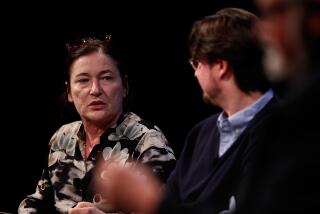Review: ‘Shadow of Night’ by Deborah Harkness is overstuffed but entertaining
Shadow of Night
A Novel
Deborah Harkness
Viking: 584 pp., $28.95
Writing second installments of planned trilogies is harder than you think. There has to be enough background from the first novel — but not too much — to give newcomers a grasp of the story while advancing the plot for readers eagerly anticipating the challenges of the new book.
Deborah Harkness laid the foundation of her “All Souls Trilogy” with “A Discovery of Witches,” which introduces historian Diana Bishop, a witch not fully aware of her powers. Studying the history of science at Oxford’s Bodleian Library, Diana examines a text known as Ashmole 782 — and her involvement with the book suddenly alerts a maelstrom of witches, vampires and daemons (with human appearances and otherworldly powers) who want it at any cost (including Diana’s life).
They believe it holds the key to the mysteries of their origins or — as the dashingly handsome vampire/research scientist/wine connoisseur Matthew Clairmont hopes — explains their mysterious loss of power and slow extinction.
By the end of “Discovery” — if you haven’t tackled it, you should stop reading this review now — Diana and Matthew have fallen in love despite their instinctual mistrust and the Congregation, a sort of United Nations of witches, vampires and daemons sworn to keep the species apart while not meddling in human affairs. The couple marry and go into the past (courtesy of Diana’s newly found timewalking skills) to search for the complete Ashmole 782 and to help Diana learn to control her unruly, witchy ways. “Together,” she says, “we lifted our feet and stepped into the unknown.”
“Shadow of Night” picks up minutes later as the newlyweds land in Matthew’s home in 1590 Woodstock, Oxfordshire. There a parade of 16th century notables begins — Christopher “Kit” Marlowe, playwright and, in Harkness’ alternative universe, a devious daemon in love with Matthew; Thomas Harriott, another daemon and astronomer; George Chapman, a human poet looking for his next patron; Henry Percy, the human Earl of Northumberland; and Sir Walter Raleigh, confidant of Queen Elizabeth and explorer of the Virginia colonies.
Matthew, whom Diana is surprised to learn is the mysterious historical figure Matthew Roydon (and a spy for Her Majesty to boot), is the sixth member of what Shakespeare would call the “School of Night,” a group of “mad, bad and dangerous to know” Elizabethans whose heretical opinions and disdain for the corrupt court of the queen won them a place in history that Diana knows well, as does Harkness. A professor of history at USC, Harkness has also written a book about an alchemical text of John Dee’s, another character in the novel.
Harkness immerses the reader in the historical and political milieu of late 16th century London and Prague, where the search for the alchemical philosopher’s stone consumes royalty and commoners alike. But “Shadow of Night” also is burdened, in its early pages, by too much detail and breathlessly introduced historical characters with limited roles to play. (Thankfully, Shakespeare remains offstage until just the right moment.) Readers new to the series will have to exercise considerable patience in the first hundred or so pages trying to absorb oblique references to “Discovery” that confuse as much as they clarify the travails Diana and Matthew endured to get to the 16th century.
Once those overstuffed pages pass, however, “Shadow of Night” is compelling as it explores an unconventional couple trying to maintain authentic intimacy despite their opposing natures and other forces attempting to pull them apart.
Coolly handsome Matthew Clairmont/Royston/de Clermont — “Scientist, Vampire, Warrior, Spy” — reveals shadowy layers of secrets, passion and raging anger that make him an irresistible, albeit sometimes maddening, lover for a 21st century woman like Diana. Also engrossing are descriptions of Diana’s training as she learns to release and use her powers, which come in handy against creatures threatening her family.
Unlike the first installment, “Shadow of Night” is told, in the 16th century, from Diana’s point of view, which misses the opportunity to show Matthew’s heroic efforts to free those condemned to death during the North Berwick witch trials in Scotland, or the daring taking of Ashmole 782. Other disconcerting habits Harkness continues include bringing in too many characters late in the action, which sometimes feels more like a setup for the third book than inevitable conflict. But as that group — wearh (another name for vampire) and witch, human and daemon — assemble at the end of “Shadow of Night,” awaiting the return of Diana and Matthew to modern times, one hopes for an all-out creature war worthy of the meandering path our heroine and hero have taken.
“Shadow of Night” is a fascinating, if somewhat flawed, entertainment displaying Harkness’ formidable historical knowledge and Renaissance talents. One hopes she continues to tame her impulses and weaves the last, magical spell in the trilogy’s final book that the series and her fans deserve.
Woods is the author of the Charlotte Justice mystery series.
More to Read
The biggest entertainment stories
Get our big stories about Hollywood, film, television, music, arts, culture and more right in your inbox as soon as they publish.
You may occasionally receive promotional content from the Los Angeles Times.






